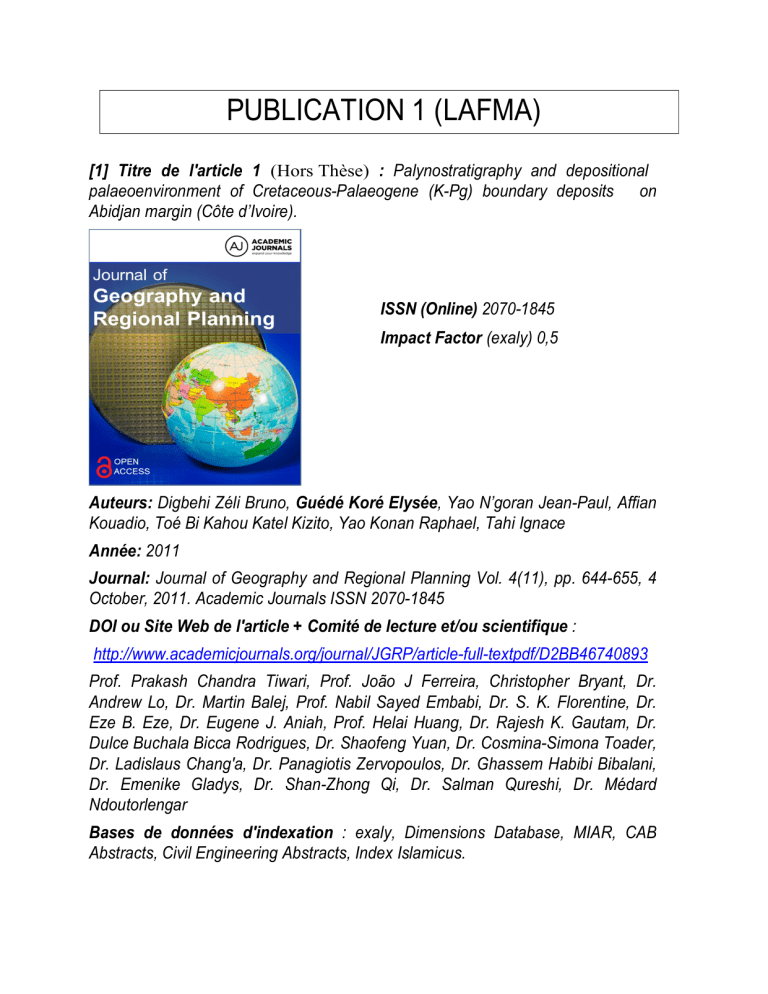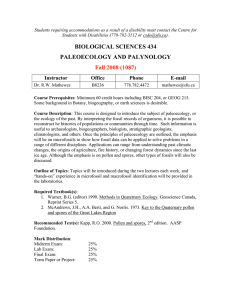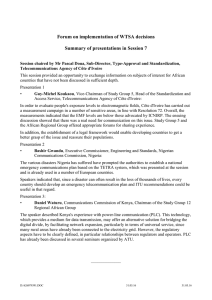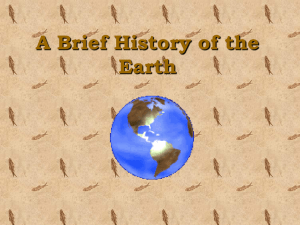Palynostratigraphy of Abidjan Margin Deposits
advertisement

PUBLICATION 1 (LAFMA) [1] Titre de l'article 1 (Hors Thèse) : Palynostratigraphy and depositional palaeoenvironment of Cretaceous-Palaeogene (K-Pg) boundary deposits on Abidjan margin (Côte d’Ivoire). ISSN (Online) 2070-1845 Impact Factor (exaly) 0,5 Auteurs: Digbehi Zéli Bruno, Guédé Koré Elysée, Yao N’goran Jean-Paul, Affian Kouadio, Toé Bi Kahou Katel Kizito, Yao Konan Raphael, Tahi Ignace Année: 2011 Journal: Journal of Geography and Regional Planning Vol. 4(11), pp. 644-655, 4 October, 2011. Academic Journals ISSN 2070-1845 DOI ou Site Web de l'article + Comité de lecture et/ou scientifique : http://www.academicjournals.org/journal/JGRP/article-full-textpdf/D2BB46740893 Prof. Prakash Chandra Tiwari, Prof. João J Ferreira, Christopher Bryant, Dr. Andrew Lo, Dr. Martin Balej, Prof. Nabil Sayed Embabi, Dr. S. K. Florentine, Dr. Eze B. Eze, Dr. Eugene J. Aniah, Prof. Helai Huang, Dr. Rajesh K. Gautam, Dr. Dulce Buchala Bicca Rodrigues, Dr. Shaofeng Yuan, Dr. Cosmina-Simona Toader, Dr. Ladislaus Chang'a, Dr. Panagiotis Zervopoulos, Dr. Ghassem Habibi Bibalani, Dr. Emenike Gladys, Dr. Shan-Zhong Qi, Dr. Salman Qureshi, Dr. Médard Ndoutorlengar Bases de données d'indexation : exaly, Dimensions Database, MIAR, CAB Abstracts, Civil Engineering Abstracts, Index Islamicus. Journal of Geography and Regional Planning Vol. 4(11), pp. 644-655, 4 October, 2011 Available online at http://www.academicjournals.org/JGRP ISSN 2070-1845 ©2011 Academic Journals Full Length Research Paper Palynostratigraphy and depositional palaeoenvironment of Cretaceous-Palaeogene (K-Pg) boundary deposits on Abidjan margin (Côte d’Ivoire) Digbehi Zéli Bruno1*, Guédé Koré Elysée1, Yao N’goran Jean-Paul1, Affian Kouadio1, Toé Bi Kahou Katel Kizito1, Yao Konan Raphael2 and Tahi Ignace2 1 Université de Cocody, UFR-STRM, 22 BP 582 Abidjan 22, Côte d’Ivoire. Petroci, Centre d’Analyses et de Recherche (CAR), BP V 194, Abidjan, Côte d’Ivoire. 2 Accepted 9 June, 2011 Palynological analysis were performed on 49 samples of cuttings from the interval 6020' to 4460 ' of an oil well Dino -1x located on Abidjan offshore margin in Côte d'Ivoire. This study proposed a palynostratigraphy and inferred a depositional environment, of which 1,560 feet thickness is mainly of gray clays. The samples first described for a lithological synthesis were then subjected to conventional chemical treatment with strong acids. The interval consisted of dark-gray clay becoming slightly calcareous towards the top. Incidentally, the glauconite and pyrite were observed. Palynological species identified revealed three intervals namely Maastrichtian, Paleocene and Eocene. Vertical distribution of this palynoflora shows two depositional environments: the first of marine neritic type with predominantly marine dinocysts from Maastrichtian to the base of Eocene, and the second of nearshore type with dominant terrestrial spores and pollen (Upper part of Eocene). The poor preservation of dinocysts along the interval was interpreted as related to many factors (physical and chemical conditions). Presence of calcareous dinoflagellates assemblages indicates a relatively warmer climate from Maastrichtian to the base of Eocene and a colder one during Upper part of Eocene whereas pollen of palms suggested tropical humid climate. Key words: Palynostratigraphy, palaeoenvironment, Maastrichtian, Palaeocene, Eocene, sedimentary basin, Côte d'Ivoire. INTRODUCTION Structural, tectonical and stratigraphical synthesis of Côte d'Ivoire sedimentary basin was recently established (Digbehi, 1987; Chierici, 1996; Sombo, 2002). Models of structural and sedimentary evolution of this basin include four phases running from rifting phase (Early Cretaceous) to complete oceanisation (late tertiary): a) The rifting phase (Barremian-Albian) with more than 5000 m of margino-marine-continental sands and clays accumulated during subsidence period, fracturing the basement in horsts and grabens. The first marine sediments are of Albian age. The absence of evaporites on Côte d'Ivoire continental margin shows that this Northern part of the Gulf of Guinea lied under humid *Corresponding author. E-mail: brunozeli_digbehi@yahoo.fr. equatorial zone during lower Cretaceous; b) The initial ocean opening phase (Cenomanian to Senonian) began by a marine transgression and a rapid decrease of subsidence during Cenomanian. Black clays and Oligostegenid limestones covered faulted blocks crests, while thick turbiditic sequences covered halfgrabens. In lower Senonian, the blocks of peaks suggested shallow marine erosion; c) The maximum opening phase took place from Campanian to Maastrichtian. Transgressive Campanian marine clays covered the blocks of peaks and halfgrabens. The Lower Senonian unconformity partly separates transgressive Campanian and underlying Cenomanian series; d) During the final opening phase (Tertiary), the Gulf of Guinea was completely open in North and South Atlantic because the equatorial fracture zones ceased acting on the barrier topography during Lower Tertiary. Bruno et al. 645 Figure 1. Location of oil well Dino-1X studied. The Tertiary most important geological event is a regression that began in Late Eocene and ended in Oligocene with partial overlapping of Miocene sediments over Early and middle Eocene series. Maastrichtian marine deposits consist of clays, but some sandy facies outcrop in the East. Paleocene marine series are welldeveloped (over 500 m) in the Western half part of the basin. They consist of argillites or glauconitic facies (Fresco) with underbedded sandy limestones, Northeast of the basin. The stratigraphy of this basin is mainly known from borehole and foraminiferal data, indicating a gradual transition at Cretaceous-Paleogene (K-Pg) boundary with very similar facies including the so-called "transitional" species (Goua, 1997; Digbehi et al., 1997). Only few palynostratigraphic published works were performed during recent decades are known (Jardiné and Magloire, 1965; Digbehi et al., 1996, 1997; Masure et al., 1996, 1998; Tea et al., 1999) and contribute significantly to a better knowledge of the subsurface stratigraphy. These results focused mainly on data from Cretaceous deposits which have oil interests. However, the National Society of Petroleum Operations in Côte d'Ivoire (Petroci) conducted some unpublished palynological studies based on cuttings and /or drill cores. Until present, very rare palynological investigations were conducted on K-Pg limit sediments from this basin except for also unpublished reports from students works, that justifies the lack of data on K-Pg limit. The present study aims at investigating palynofloras from a section of an oil well Dino-1x (5° 01'20''N 4° 36' 14''W) located offshore off Abidjan, from a palynostratigraphical and palaeoenvironmental point of view. MATERIALS AND METHODS 49 cuttings samples were processed according to standard palynological procedures as adopted in recent works (Prost, 2001; Pearson et al., 2004; Guastia et al., 2005). Palynomorphs assemblages were studied in these samples from the interval 6020' to 4460' of an oil well Dino -1x which was drilled in the sub-central part of Abidjan offshore margin (Figure 1). The sediments analyzed consist of 1 560 feet thick of mainly friable subfissile gray clays, finely micaceous and slightly enriched in carbonates towards the top. About 20 g of material were diluted in 37% HCl and treated with 37% HF. A treatment with KOH and HCl was performed to dissolve KF. To break up amorphous organic matter obscuring the palynomorphs, a short oxidation with 67% HNO3 followed by neutralization with KOH was necessary. Subsequent to each chemical preparation step, the material was sieved through a 10 mm nylon screen. After each step involving the use of KOH or HNO3 the samples were checked for the effect of these oxidation procedures on the dinockysts assemblages. Each sample necessitated a short ultrasonic treatment in order to achieve a better dispersion of the residue. Slides are stored in the collection of the Laboratory of Biostratigraphy at University of Cocody, Abidjan. Palynomorphs were counted up to 50 determinable specimen where possible. For qualitative and quantitative study, at least two permanent slides per productive sample were prepared 646 J. Geogr. Reg. Plann. Dinocysts Spores and pollen Figure 2. Vertical distribution of palynomorphs in the oil well Dino-1X during Maastrichtian and Paleocene. using Canada basalm as mounting medium. The slides were examined using a Motic light microscope equipped with a Motic digital camera. Dinocysts taxonomy was in accordance with Williams et al. (1998) and other sporomorphs with Potonie morphographical classification (1974). In order to obtain the main variations of the paleoecological signal along the succession, two models were combined (Chateauneuf and Reyre, 1974; Michoux, 2002 cited by Demchuck et al., 2008). In both models, depositional environments run from a continental shelf with terrestrial palynoflora dominant to an outer continental-shelf dominated by dinoflagellates cysts and inner walls of foraminifera. RESULTS Palynostratigraphy The subfissile gray clays analyzed contain dominant marine dinocysts assemblage (87.56 pc) more or less well preserved in regards to terrestrial pollen and spores. These dinocysts include diverse species of the genera Andalusiella, Cerodinium, Senegalinium, Phelodinium and Homotryblium. Terrestrial pollen and spores are represented by the genera Distaverrusporites, Spinizonocolpites, Mauritiidites and Margocolporites. This palynoflora reveals three stratigraphic intervals (Figures 2 and 3). A Maastrichtian age is suggested for the lower subfissile gray clays facies (6000' to 5560') based on the occurrence of well known Maastrichtian marine dinoflagellates Andalusiella mauthei (Figure 5a), Andalusiella gabonensis (Figure 5b), Cerodinium granulostriatum (Figure 5c), Senegalinium microspinosum (Figure 5d). Associated with these forms also are some Maastrichtian spores and pollen: Distaverrusporites simplex and Spinizonocolpites baculatus. Paleocene (5560' to 5270') was suggested, for Bruno et al. Dinocysts 647 Spores and pollen Figure 3. Vertical distribution of palynomorphs in the oil well Dino-1X during Eocene. the middle relatively sandy layer, based on occurrence of dinocysts species Cerodinium leptodermum (Figure 5e) and Phelodinium magnificum associated to Cerodinium diebeli (Figure 5f). Rare species of pollen grains as Mauritiidites lehmani (Figure 6d) are encountered. An Eocene age was attributed to the uppermost slightly enriched in carbonates unit (5270’ to 4460’) by marine dinocysts assemblage based on the occurrence of various species of Homotryblium as Homotryblium abbreviatum, Homotryblium pallidum (Figure 6a) and Homotryblium tenuispinosum (Figure 6b) associated to Adnatosphaeridium multispinosum (Figure 6c) and pollen species Margocolporites nauvolfi (Figure 6e and f). Evolution of depositional settings The marine dinocysts assemblage from Maastrichtian up to the base of Late Eocene, (Figure 4) is poorly preserved, J. Geogr. Reg. Plann. Depth (feet) 648 Figure 4. Synthesis of lithology, palynofacies and relative abundance of palynomorphs with associated depositional environments variation throughout study interval in oil well Dino-1X. unlike terrestrial pollen and spores. This assemblage reflects influence of shallow marine process during deposition of these gray clays with organic matter that consists of small orange, brown to black wood debris. The presence of glauconite reflects a deposition under marine poorly oxygenated settings. During Late Eocene, the relative explosion of terrestrial pollen and spores (27%) reflects a stronger continental influence (nearshore) in this interval with large darker organic matter. DISCUSSION Approaches of K-Pg boundary study are becoming more and more various and fine today. Some are based on chemiotratigraphy (Ferrow et al., 2011), others on purely biostratigraphical unitary data (palynology, micropaleontology) or combined (Crouch et al., 2003; Hildebrand-Habel and Streng, 2003; Galeoti et al., 2004; Rochon et al., 2008). In palynological plan, quantitative and qualitative changes in the composition of the Bruno et al. a 649 b c d e f Figure 5. a) Andalusiella mauthei, b) Andalusiella gabonensis, c) Cerodinium granulostriatum, d) Senegalinium microspinosum, e) Cerodinium leptodermum, f) Cerodinium diebeli. terrestrial (pollen and spores) and marine (dinoflagellates) palynofloras are usually controlled by a number of factors which are not easy to interpret in detail (Mahmoudi and Schrank, 2007; Richter, 2007). These include temperature of surface waters, salinity, shape of processes, mode of nutrition, climate, sedimentation rate, density, nitrate, phosphate and chlorophyll concentrations, etc. Because dinocysts notably exhibit high abundance in neritic settings, dinocyst-based environmental and palaeoclimatic data, according to Sluijs (2005), is important and complementary to the data derived from typically more offshore groups as planktonic foraminifera and other microplankton. Despite uncertainties about taxonomical identity and limitations due to taphonomical processes (Rochon et al., 2008), dinoflagellates cysts provide extremely useful and unique information on marine environments of the past. Based of nutritional plan, Powell et al. (1992) cited by 650 J. Geogr. Reg. Plann. b a c d e f Figure 6. a) Homotryblium pallidum, b) Homotryblium tenuispinosum, c) Adnatosphaeridium multispinosum, d) Mauritiidites lehmani, e and f) Margocolporites novaulfi. Bruno et al. Sluijs (2005), indicated that Geridinoids cysts (P-cysts) are considered to predominantly represent heterotrophic dinoflagellates whereas Gonyaulacoids-cysts (G-cysts) mainly represent autotrophic forms. Moreover, the dinocysts associations with high relative abundance of heterotrophic species are usually observed in neritic regions (Holzwarth et al., 2007), characterized by high chlorophyll and low salinity conditions in surface waters. Finally, the wide distribution of current calcareous dinoflagellates was recently illustrated by means of 61 charts by Marret and Zonneveld (2003) in recent sediments from the Atlantic and adjacent basins. In the present work and data collected, only palynostratigraphic and palaeoenvironemental aspects are discussed and alternative palaeogeographic and palaeoclimatologic aspects are approached. Palynostratigraphical context Most of the Maastrichtian palynomorphs identified in the present work are known in basins along the East Atlantic coast including Côte d'Ivoire (Masure et al., 1996, 1998), Gabon (Boltenhagen, 1977), Nigeria (Lawal, 1982; Fazzari and Biffi, 1984; Oboh-Ikuenobe et al., 2005; Olusola, 2009) and Niger (Boudouresque, 1980) and Ghana (Atta-Peters and salami, 2004). This is especially Maastrichtian assemblage including A. mauthei, A. gabonensis and other C. granulostriatum. The extinction of these species marks the Cretaceous-Palaeogene (KPg) limit in 5560 feet deep. But here, a number of well known Maastrichtian dinocysts recently described in Southeastern Bida Basin, Nigeria (Olusola, 2009) are absent notably Dinogymnium acuminatum, Dinogymnium digitus, Senegalinium bicavatum and Senegalinium psilatum as well as spores and pollen species including Buttinia andreevi, Cristaeturites cristatus and Retidiporites magdalenensis. Moreover, terrestrial pollen grains are mainly represented in our study by S. baculatus whereas three others lacked namely Echitriporites trianguliformis, Auriculiidites reticulatus and Rhoipites hirtzii. Among dinocysts described in the present study, some biostratigraphically significant such as Andalusiella and C. granulostriatum began in Campanian as indicated by Mahmoud and Schrank (2007) in Aswan area, Southern Egypt. Similarly, during Paleocene, three of the main marine dinocysts species identified namely P. magnificum, C. diebeli and C. leptodermum, confirm this interval in Nigeria (Lawal, 1982; Fazzari and Biffi, 1984), but also elsewhere in the Northern Hemisphere (Graham et al., 1993; Williams et al., 2004; Fensome et al., 2008, 2009). Species such as A. multispinosum, H. pallidum, H. abbreviatum, H. tenuispinosum and Apectodinium quinquelatum (very rare), characterize Eocene (Williams et al., 2004; Fazzari and Biffi, 1984; Fensome et al., 2008, 2009). Homotryblium first occurred in the Early 651 Paleocene (Lakovleva and Kulkova, 2001) and has a last occurrence in the Mid-Miocene according to Brinkhuis (1994) cited by Sluijs (2005). Depositional palaeoenvironments The dominance of dinoflagellates cysts in regards to spores and pollen within the lower interval (MaastrichtianBasis of Late Eocene) evokes marine deposition, in agreement with Chateauneuf and Reyre (1974). In contrast, spores and pollen grains are virtually absent in this interval. Based on the model of Michoux (2002) cited by Demchuck et al. (2008), the marine origin of dinoflagellate cysts described here was supported by the lack of freshwater algae in assemblages. But when combined the two models, rarity of chitinous inner linings of foraminifera was recorded, and added to a poor conservation of dinocysts, compared to terrestrial spores and pollen. The causes of this poor conservation might lie in burial physico-chemical conditions in grabens or depocentres located often nearshore in Côte d'Ivoire sedimentary basin (Digbehi, 1987; Digbehi et al., 1996). The increase in the rate of terrestrial material within the Upper part of Eocene appears as the consequence of sea level drop occurred in Côte d'Ivoire sedimentary basin during K-Pg limit (Oboh-Ikuenobe et al., 1997). Concerning this sharp deterioration of dinocysts, it is also possible that this drop causes decreasing of the water column and induces turbulences in depositional settings. Moreover, hydrothermal episodes induced by displacement of transform fractures zones, notably within Côte d’Ivoire-Ghana Ridge both sides of the Ivorian margin (Saint-Marc and N'da (1997) by releasing hot and acidified water, and could also lead to poor conservation of dinocysts (calcareous algae) of the pelagic marine part of the interval studied. This poor conservation might finally be due to oxidation of organic matter often intensive in open ocean settings with generally low sedimentation rates as observed Sluijs (2005). It is established that dinocysts are also among the most resistant organic particles and also represent important primary producers in the upper water column; so this poor conservation can be interpreted as due to only hydrodynamic turbulences. Moreover, Richter et al. (2007), indicated that in general, high accumulation rates of calcareous dinocysts were found with slightly lower accumulation rates in the upwelling-influenced areas. In terms of phythoplanktonic productivity, the works of van Mourik et al. (2001) cited par Sluijs (2005), showed that high abundance of P-cysts were used to indicate phases of enhanced nutrient availability probably derived from stronger terrigenous input. Similarly, Sluijs et al. (2003) cited by Sluijs (2005), high relative abundance of P-cysts in Maastrichtian-Lower part of Eocene can be interpreted to reflect a supply of nutrients from land. According to Gedl (2007), the predominance of P-cysts 652 J. Geogr. Reg. Plann. may indicate eutrophic conditions in the diluted offshore photic zone induced by upwelling phenomena. Mahmoudi and Schrank (2007), indicated that proximate cysts such as Cerodinium are abundant in a shallow marine (inner shelf) and normal salinity environment whereas dinoflagellates with complex processes (Spiniferites), which tend to become more common in open shelf environments are rare. Sluijs (2005), citing Brinkhuis (1994), showed that among Paleogene and Neogene dinocyst taxa, members of Homotryblium complex and other taxa of the family Goniodomaceae are widely considered to be characteristic of restricted settings with increased salinity. In the same way, Sluijs (2005) showed that high abundance of H. tenuispinosum and Homotryblium floripes (not identified in this study) reflected drier periods where reduced runoff, in combination with strong evaporation, led to increased salinity in nearshore. Kothe (1990) interpreted intervals of high Homotryblium abundance in the Oligocene and Miocene of northwest Germany to indicate high-salinity conditions. Nevertheless, according to the same author, acmes of H. tenuispinosum were also recorded alongside high abundance of the freshwater algae Pediastrum spp. which indicates a brackish setting. They concluded that although most available records suggest an affinity of Homotryblium to hypersaline environments, there are indications that the genus may also have favoured abnormally low salinity conditions. The deepening of the ocean, immediately after the K-pg boundary as well as the softening extended climate phenomena are known elsewhere (Galeoti et al., 2004). In this work however, this deepening was quickly attenuated before the end of Eocene when the subsidence, according to Digbehi (1987) and Chierici (1996), was stabilized. This could partly explain the superposition of seashore deposition (dominated by terrestrial pollen and spores) on marine neritic deposits (dominated by dinoflagellate cysts). Botanical affinities and sketch of palaeoecological and palaeoclimatical evolution Palaeoecological and palaeoclimatical considerations here are mainly based on changes in the bulk composition of palynoflora and the botanical affinities of selected palynomorphs (Appendix). The relative frequency of some spores, mainly Deltoidospora indicates presence of pteridophyts. Within this palynoflora are represented P-cysts, mainly C. granulostriatum and A. mauthei, A. gabonensis, and G-cysts such as Adnatosphaeridium and Spiniferites. Gymnosperms are mostly represented by number of undetermined inaperturate pollen (Inaperturopollenites spp.). Angiospermous pollen are dominated by palms (Monosulcites spp. and S. baculatus). In accordance to Mahmoud and Schrank (2007) and to Eisawi and Schrank (2008), Late Cretaceous Palmae province is mainly represented here by S. baculatus and suggests tropical humid climate areas as well as Spinizonocolpites traduces a mangrove belt. Moreover, Hildebrand-Habel and Streng (2003) suggested that calcareous dinoflagellates assemblages indicate a relatively warmer climate during Maastrichtian and colder one during Neogene. Within such assemblages, Guasti et al. (2005) cited by Mahmoud and Schrank (2007) showed that high abundances of P-cysts were assumed to indicate a low salinity and/or high nutrient environment. Despite the absence of Ariadnaesporites, presence of palm pollen and pteridophytic spores related to water ferns (VajdaSantivanez, 1999; Atta-Peters and salami, 2004; Rochon et al., 2008) confirmed this prevalence of humid tropical conditions during the deposition of the sediments examined. Moreover, mangrove pollen common in West African coastal basins are species Spinizonocolpites (Nypa) as described in works of Eisawi and Schrank (2008). Conclusions The palynological study of the interval 6020' to 4460' of the oil well Dino-1x was documented by sediments consisting mainly of dark clays slightly upward carbonated sequence. It led to propose a palynostratigraphic scale and a depositional environment model from Maastrichtian to Eocene. Many taxa characterizing Maastrichtian (6020' to 5560'), Paleocene (5560' to 5270') and Eocene (5270' to 4460 ') were identified. Most of these species well known in periAtlantic basins confirmed the palynostratigraphical scale proposed. Two depositional environments were identified: the one (Maastrichtian-Base of Eocene), rich in small marine neritic organic matter dominated by neritic marine dinoflagellates cysts; the other (Upper part of Eocene), nearshore is rich in large particles of organic matter with a relative explosion of terrestrial spores and pollen grains. The poor preservation of dinocysts along the interval was interpreted as related to physical and chemical conditions which prevailed in the depositional settings during a probably drop of sea level that caused decreasing of the water column and induced turbulence. Presence of calcareous dinoflagellates assemblages indicates a relatively warmer climate during Maastrichtian-Base of Eocene and a colder one during Upper part of Eocene whereas pollen of palms suggests tropical humid climate. ACKNOWLEDGEMENTS The authors wish to thank la Petroci which allowed them to carry out this study. Bruno et al. REFERENCES Atta-Peters D, Salami MB (2004). Late Cretaceous to Early Tertiary pollen grains from offshore Tano basin, Southwestern Ghana. Revista Española de Micropaleontología, 36(3): 451-465. Boltenhagen E (1977). Upper Cretaceous microplankton of Gabon. Cah. Palaeont, p. 150. Boudouresque L (1980). Contribution of the palaeopalynology of the floristic, stratigraphic and paleogeographic reconstitution of the western edge of Iullemeden basin during Upper Cretaceous and Paleogene (Mali and Niger, West Africa). PhD thesis specialty, University of Niamey, p. 245. Chateauneuf JJ, Reyre Y (1974). Elements of palynology. Geological applications. Graduate Course in Earth sciences. p. 345. Chierici MA (1996). Stratigraphy, palaeoenvironnements and geological evolution of the Ivory Coast-Ghana basin. In Jardiné, S., Klasz I (de) & Debenay, J.P. (Eds) – Geology of Africa and South Atlantic. Acta of Angers colloquia July, 16-20, 1994. Elf- Aquitaine, Mem., 16: 293311. Crouch ER, Dickens MG, Brinkhuis H, Aubry MP, Hollis CJ, Rogers KM, Visscher H (2003). The Apectodinium acme and terrestrial discharge during the Paleocene-Eocene thermal maximum: new palynological, geochemical and calcareous nannoplankton observations at Tawanui, New Zealand. Palaeogeogr. Palaeoclimatol. Palaeoecol., 194: (2003) 387-403. Demchuck TD, Dolby G, Mcintyre DJ, Suter JR (2008). The utility of palynofloral assemblages for the interpretation of depositional paleoenvironments and sequence stratigraphic systems tracts in the McMurray Formation at Surmont, Alberta. Search and Discovery (2008). p. 6. Digbehi ZB (1987). Comparative study of sedimentation in the early stages of opening of the Atlantic: Gulf of Guinea Gulf of Biscay. Sedimentology, biostratigraphy. Ph.D Thesis University, PAU. T1 & 2. p. 366. Digbehi ZB, Yao KR, Tea YJ, Boblai G (1996). Contribution to palynological and environmental study of Campanian Maastrichtian series in Ivory Coast ‘offshore' basin. Géologie Méditerranéenne. 23 (2): 155-171. Digbehi ZB, N’da LV, Yao KR, Atteba YA (1997). Main Cretaceous foraminifera and palynomorphs in Côte d'Ivoire sedimentary basin, northern Gulf of Guinea: proposals for a local biostratigraphic scale. Afr. Geosci. Rev., 4(3&4): 461-473. Eisawi A, Schrank E (2008). Upper Cretaceous to Neogene palynology of the Melut Basin, southeast Sudan. Palynol., 32: 101–129. Fazzari F, Biffi U (1984). Microfossils and palynomorphs of Anambra basin (Nigeria), Late Eocene to Early Senonian. AGIP, June 1984. p. 14. Fensome RA, Crux JA, Gard IG, Macrae RA, W illiams GL, Thomas FC, Fiorini F, W ach G (2008). The last 100 million years on the Scotian margin, Offshore eastern Canada: an event-stratigraphic scheme emphasizing biostratigraphic data. Atlantic Geol., 44: 93-126. Fensome RA, W illiams GL, Macrae RA. (2009). Late Cretaceous and Cenozoic fossil dinoflagellates and other palynomorphs from the Scotian Margin, offshore Eastern Canada. J. Syst. Palaeontol., Cambridge University Press (2009). 7: 1-79. Ferrow E, Vajda V, Koch CB, Peucker-Ehrenbrink B and W illumsen PS (2011). Multiproxy analysis of a new terrestrial and a marine Cretaceous–Paleogene (K–Pg) boundary site from New Zealand Geochimica et Cosmochimica Acta, 75(2): 657-672. Galeoti S, Brinkhuis H and Huber M (2004). Records of post– Cretaceous-Tertiary boundary millennial-scale cooling from the western Tethys: A smoking gun for the impact-winter hypothesis? Geol., 32(6): 529–532. Gedl P (2007). Dinocysts from Up per Cretaceous deep-water marinevariegated facies (Malinowa Shale Formation), Pieniny Klippen Belt, Po land: example from the Potok Trawne creek. Studia Geologica Polonica, 127: 139–152. Goua TE (1997). Biostratigraphy and palaeoenvironmental evolution of Maastrichtian and Paleocene series in the Ivorian coastal sedimentary basin. PhD thesis, University of Bourgogne, Earth science center, p. 354. Guastia ET, Kouwenhovenb TJ, Brinkhuisc H, Speijer RP (2005). 653 Paleocene sea-level and productivity changes at the southern Tethyan margin (El Kef, Tunisia). Marine Micropaleontol., 55: 1-17. Graham L, Williams LES, Evan JK (1993). Morphology and stratigraphic ranges of selected Mesozoic-Cenozoic Dinoflagellate taxa in the northern Hemisphère. Ottawa: Geological Survey of Canada, p. 137. Hildebrand-Habel T, Streng M (2003). Calcareous dinoflagellate associations and Maastrichtian–Tertiary climatic change in a highlatitude core (ODP Hole 689B, Maud Rise, Weddell Sea) Palaeogeogr. Palaeoclimatol. Palaeoecol., 197(3-4): 293-321. Holzwarth U, Esper O, Zonneveld K (2007). Distribution of organicwalled dinoflagellate cysts in shelf surface sediments of the Benguela upwelling systemin relationship to environmental conditions. Marine Micropaleontol., 64(1-2): 91-119. Jardine S, Magloire L (1965). Palynology and stratigraphy of Senegal and Côte d’Ivoire Cretaceous basins Mem. Bur. Rech. Geol. Min., 32: 187-245. Lakovleva AI, Kulkova IA (2001). Paleocene–Eocene dinoflagellate zonation of Western Siberia. Review of Palaeobot. Palynol., 123(3-4): 185-197. Lawal O (1982). Palynological biostratigraphy and palaeoenvironment of Cretaceous formations of Upper Benue, North-East Nigeria. Specialty PhD thesis, University of Nice. 614: 199. Mahmoud MS, Schrank E (2007). Late Cretaceous spores, pollen and dinoflagellates from two boreholes (Nuqra-1. and 3) in the Aswan area, southeast Egypt Revue de Paléobiologie, Genève, 26(2): 593613. Marret F, Zonneveld KAF (2003). Atlas of modern organic-walled dinoflagellate cyst distribution. Rev. Palaeobot. Palynol., 125(1-2): 1200. Masure E, Tea YJ, Yao KR (1996). The dinoflagelleate Andalusiela: emendation of genus, revision of species, A. ivoiriensis Masure, Tea and Yao, sp. nov. Rev. paleobot. Palynol., 91: 171-186. Masure E, Rauscher R, Dejax J, Schuler M, Ferre B (1998). Cretaceous–Paleocene palynology from the Côte d’Ivoire–Ghana transform margin, sites 959, 960, 961and 962. Proceedings of the Ocean Drilling Program, Scientific Results. 159: 253–276. Oboh-ikuenobe FE, Yepes O, Leg ODP (1997). Palynofacies analysis of sediments from the Côte d'Ivoire-Ghana transform margin: Preliminary correlation with some regional events in the Equatorial Atlantic. Palaeogeogr. Palaeoclimatol. Palaeoecol., 129: 291-314. Oboh-ikuenobe FE, Obi CG, Jaramillo CA (2005). Lithofacies, palynofacies, and sequence stratigraphy of Palaeogene strata in Southeastern Nigeria. J. Afr. Earth Sci., 41: 79–101. Olusola OJ (2009). Occurrence of some Maastrichtian dinoflagellate cysts from the Upper Cretaceous sediments in Southeastern Bida basin, Nigeria: implications for age and paleoenvironments. J. Applied Sci., 2(3): 291-305. Pearson PN, Nicholas CJ, Singano JM, Bown PR, Coxall HK, van Dongen BE, Huber BT, Karega A, Lees JA, Msaky E, Pancost RD, Pearson M, Roberts AP (2004). Paleogene and Cretaceous sediment cores from the Kilwa and Lindi areas of coastal Tanzania: Tanzania Drilling Project Sites 1–5. J. Afr. Earth Sci., 39: 25–62. Pross J (2001). Paleo-oxygenation in Tertiary epeiric seas: evidence from dinoflagellate cysts. Palaeogeogr. Palaeoclimatol. Palaeoecol., 166: 369-381. Rochon A, Eynaud F, de Vernal A (2008). Dinockysts as tracers of hydrographical conditions and productivity along the ocean margins: Introduction. Marine Micropaleontol., 68: 1–5. Saint-Marc P, N’da V (1997). Biostratigraphy and paleoenvironments of Cretaceous deposits off Abidjan (Gulf of Guinea). Cretaceous Res., 18: 545-565. Sluijs A, Prossa J, Brinkhuis H (2005). From greenhouse to icehouse; organic-walled dinoflagellate cysts as paleoenvironmental indicators in the Paleogene. Earth-Sci. Rev., 68: 281–315 Sombo BC (2002). Study of the seismic stratigraphy and structural evolution of Cote d’Ivoire sedimentary offshore basin, passive margin notched by a canyon. PhD thesis in Earth Sc. Univ. Abidjan, p. 304. Tea-Yassi J, Digbehi ZB, Yao KR, Boblai V (1999). Study of some palynomorphs of Upper Cretaceous in Cote d’Ivoire sedimentary "Offshore" basin. Biostratigraphic and paleoenvironmental implications. J. Afr. Earth Sci., 29(4): 783-798. Vajda-Santivanez V (1999). Miospores from Upper Cretaceous- 654 J. Geogr. Reg. Plann. Paleocene strata in Northwestern Bolivia. Palynology; 23(1): 181196. Williams GL, Lentin JK, Fensome RA (2004). The Lentin and W illiams Index of fossil Dinoflagellates, 2004 (Edit.) AASP contributions Series, 34. Bruno et al. APPENDIX Index of different species of palynomorphs identified in this study (NB the diagnostic species are marked with an asterisk *). Dinoflagellate cysts (dinocysts) *Adnatosphaeridium huenickenii (Archangelsky, 1969) *Adnatosphaeridium multispinosum (Williams and Downie, 1966) *Adnatosphaeridium patulum (Williams and Downie, 1966) *Andalusiela gabonensis (Stover and Evitt, 1978) Andalusiella ivoirensis (Masure, Tea et Yao, 1996) *Andalusiela mauthei (Riegel, 1974; emend Masure et al., 1996) Areoligera gippingensis (Jolley, 1992) Batiacasphaera spp. *Cerodinium diebelii (Alberti, 1959; Lentin and Williams, 1987) *Cerodinium granulostriatum (Jain and Millepied, 1973) *Cerodinium leptodermum (Vozzhennikova, 1963) *Cerodinium wardenense (Williams and Downie, 1966c; Lentin and Williams, 1987). Cleistosphaeridium diversispinosum (Davey et al., 1966) Cordosphaeridium exilimurum (Davey and Williams, 1966) *Cordosphaeridium fibrospinosum (Davey and Williams, 1966) *Cordosphaeridium gracile (Eisenack, 1954; Davey et Williams 1966) Cordosphaeridium inodes (Eisenack, 1963; emend Davey, 1969). Cordosphaeridium minimum (Morgenroth, 1966; Benedek, 1972) Cribroperidinium exilicristatum (Davey, 1969; Stover and Evitt, 1978) Dapsilidinium pseudocolligerum (Stover, 1977; Bujak et al., 1980) *Diphyes colligerum (Deflandre and Cookson, 1955; Cookson, 1965) Fibrocysta axialis (Eisenack, 1965; Stover and Evitt, 1978) *Homotryblium abbreviatum (Batton, 1976) *Homotryblium pallidum (Davey and Williams, 1966b) *Homotryblium tenuispinosum (Davey et al., 1966b) Hafniasphaera septata (Cookson and Eisenack, 1967; Hansen, 1977) Hystrichokolpoma cf. unispinum (Williams and Downie, 1966a) Kallosphaeridium capulatum (Stover, 1977) Kallosphaeridium cf. brevibarbatum (De Coninck, 1969) *kallosphaeridium yorubaensis (Jan du Chêne and Adediran, 1985) 655 Palaeocystodinium australinum (Cookson, 1965b; Lentin and Williams, 1976) Palaeocystodinium golzowense (Alberti, 1961) Phelodinium africanum (Biffi and Grignani, 1983) *Phelodinium magnificum (Stanley, 1965; Stover and Evitt, 1978) Phelodinium nigericum (Biffi and Grignani, 1983) Phelodinium spp. *Senegalinium microspinosum (Boltenhagen, 1977) Spiniferites mirabilis (Rossignol, 1964; Sarjeant, 1970) Spiniferites ramosus (Ehrenberg, 1938; Mantell, 1954) Spiniferites splendidus (Harland, 1979) Spores and pollen grains Cicatricososporites norrisii (Srivastava, 1971) Cingulatisporites spp. Cyathidites minor (Couper, 1953) Deltoidospora australis (Couper, 1953 ; Pocock, 1970). Deltoidospora spp Distaverrusporites simplex (Muller, 1968) Inaperturopollenites spp. Magnastriatites howardii (Germeraad et al., 1968) Margocolporites nauvolfii (Ramanujan, 1966 ex Potonie, 1970) Mauritiidites crassibaculatus (Van Hoeken Klinkenberg, 1964) Mauritiidites lehmani (Van Hoeken Klinkenberg, 1964) Monosulcites spp. Pterospermopsis danica (Wetzel, 1952) Retitricolporites irregularis (Van der Hammen and Wijmstra, 1964) Spinizonocolpites baculatus (Muller, 1968) Verrucatosporistes usmensis (Van der Hammen) Germeraad et al., 1968



